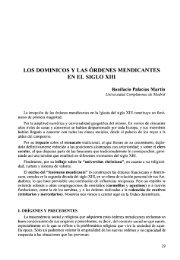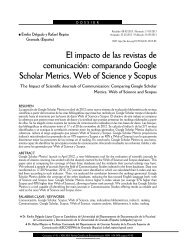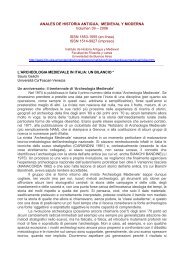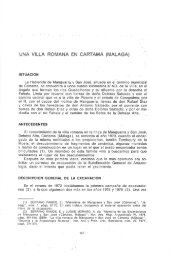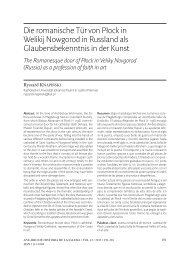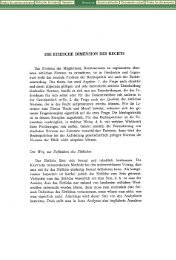Roslyn M. Frank 1.0. Introduction In the first chapter of this ... - Dialnet
Roslyn M. Frank 1.0. Introduction In the first chapter of this ... - Dialnet
Roslyn M. Frank 1.0. Introduction In the first chapter of this ... - Dialnet
Create successful ePaper yourself
Turn your PDF publications into a flip-book with our unique Google optimized e-Paper software.
102 <strong>Roslyn</strong> M. <strong>Frank</strong><br />
to be no objective way to cross-check whe<strong>the</strong>r or not a PIE item belongs to a<br />
Mesolithic lexical set. <strong>In</strong> that sense, it suffers from some <strong>of</strong> <strong>the</strong> same defects that<br />
have been pointed out by o<strong>the</strong>rs in <strong>the</strong> case <strong>of</strong> attempts to reconstruct Proto-IE<br />
society and culture (Arvidsson 2006). Likewise, as Arvidsson observes, reconstructions<br />
proposed in <strong>the</strong> nineteenth and early twentieth centuries, were <strong>of</strong>ten<br />
totally contradictory, e.g., <strong>the</strong> reified IE people were <strong>first</strong> portrayed as noble,<br />
industrious and peaceful farmers, i.e., sedentary agriculturalists; later on <strong>the</strong>ir<br />
society was redrawn to make <strong>the</strong>m patriarchal chariot-driving warrior nomads,<br />
etc. Most <strong>of</strong> us are familiar only with <strong>the</strong> most recent (re)constructions <strong>of</strong> Proto-<br />
IE society and culture and <strong>the</strong> debates surrounding <strong>the</strong>m (e.g., <strong>the</strong> twentieth<br />
century competition between <strong>the</strong> models <strong>of</strong> Gimbutas and Renfrew). 5 Therefore,<br />
we are less familiar with <strong>the</strong> details surrounding <strong>the</strong> way that reconstructions<br />
<strong>of</strong> etymons relating to one domain or ano<strong>the</strong>r were used in times past as<br />
evidence for identifying and assigning one concrete feature or ano<strong>the</strong>r to Proto-<br />
IE society and culture in <strong>the</strong> period before <strong>the</strong> so-called «<strong>In</strong>do-Europeans» (extrapolating<br />
once again from «language» to «race») began to expand out <strong>of</strong> <strong>the</strong>ir<br />
putative homeland. Similarly, over <strong>the</strong> past several hundred years, <strong>this</strong> homeland<br />
has been sedulously repositioned by investigators and as a result has ended<br />
up in quite different locations (Koerner 2001; Mallory 1997).<br />
Yet all <strong>of</strong> <strong>the</strong>se attempts to reconstruct <strong>the</strong> deepest chronological layers<br />
<strong>of</strong> <strong>the</strong> putative Proto-IE society and culture are grounded in fundamentally<br />
<strong>the</strong> same kind <strong>of</strong> pro<strong>of</strong>s: linguistic ones. A lexical item found across several<br />
different branches <strong>of</strong> IE languages is viewed as a good candidate for <strong>the</strong>se<br />
reconstruction efforts, even more so if <strong>the</strong> semantic item in question could<br />
have referred to an element found in <strong>the</strong> conceptual toolkit <strong>of</strong> Bronze Age<br />
peoples, or, in <strong>the</strong> case <strong>of</strong> <strong>the</strong> PC model, to an item encountered in <strong>the</strong> conceptual<br />
toolkit <strong>of</strong> Mesolithic or Upper Palaeolithic hunter-ga<strong>the</strong>rers. However,<br />
in both cases <strong>the</strong> pro<strong>of</strong> is based on a reconstruction, a putative etymon,<br />
which is assumed to correspond to a cultural conceptualization <strong>of</strong> significant<br />
antiquity (most especially if <strong>the</strong> etymon in question can be linked to<br />
material remains found in <strong>the</strong> archaeological record and/or ecosystems existing<br />
at <strong>the</strong> particular time period in question).<br />
<strong>In</strong> <strong>this</strong> sense, <strong>the</strong> research models share a common denominator: that over<br />
significant periods <strong>of</strong> time <strong>the</strong> meaning <strong>of</strong> <strong>the</strong> reconstructed etymon remained<br />
5 For example, in <strong>the</strong> review article by Diamond and Bellwood (2003) which includes significant<br />
discussion <strong>of</strong> genetics, <strong>the</strong> only models mentioned with respect to <strong>In</strong>do-European are those <strong>of</strong><br />
Gimbutas and Renfrew.



